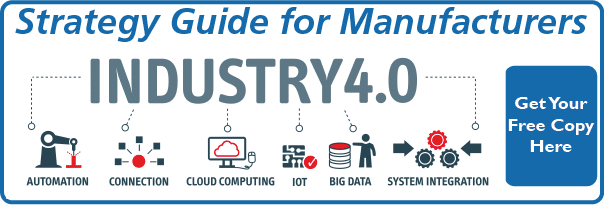
Between Sanguine and Alarmist
It's safe to say that nobody knows how the current situation will play out from a public health or business perspective. Tyler Cowen's Bloomberg article illustrates the breadth of the continuum of outcomes that we face.
It's time to think about business scenarios for the typical middle market manufacturer.
Other resources will help with health and safety topics. Keeping your factory humming with healthy workers and Duty of Care for traveling employees are important topics. But you've got that.
Let's talk short, medium and long-term business considerations; protecting cash flow, improving procurement, and anticipating manufacturing changes respectively.
Short-term: Watch Your Buyers' Buyers
There will be at least financial ripples. A single slow payment on a large contract could leave an SMB customer insolvent - even if they've never paid late and that payment is unrelated to your work.
Imagine the exposure of companies selling to any facet of the events, trade show or travel industries now. Even if a company's cruise industry related customers don't reorganize or liquidate, they'll certainly move to preserve cash. That means slow payments. And cash is the lifeblood of most SMBs.
Supply chain disruptions are also going to play out in some dramatic ways. Otherwise viable and vibrant companies which rely on a specific but limited range of components or materials sourced from China are likely to miss deliveries. If their contracts include cancellation clauses which didn't contemplate this scenario (read the SXSW story about their insurance) then it doesn't matter how "Force Majeure" might eventually be litigated - they're going to miss. They won't get paid. They'll fight to survive. That means you won't get paid - at least not close to on time.
Some companies might not be exposed directly but have the misfortune of having just expanded. They'll likely find themselves overextended.
And as soon as commercial financing covenants are tripped, banks who will be jumpy in the current environment will react, and all bets are off.
So you've got to understand your buyers' buyers and their businesses to anticipate where there may be issues. Here's the catch. As smart as you are, you'll still be caught unawares. That means two critical steps in the short term.
Expect that some of your receivables, perhaps even critical ones, will be unrecoverable within the timeframe that's important for your cash flow. They may be simply delayed, or perhaps frozen pending discharge. So you need to protect yourself.
Explore receivables insurance. Often thought of as an option for international receivables, there are carriers and programs which will insure domestic receivables as well. Some are blanket while others are specific to certain receivables. Understanding what's considered default and what's covered are critical. For instance, will any invoice past 90 days be paid by the insurer? Or only certain ones?
Generally premiums and deductibles are modest - in the range of 1% and 10% respectively - and insured receivables may be an important bankable asset from your lendor's perspective. If you want an introduction to a resource, email me and I'll make one. (no affiliate or commission involved)
Secondly, check with your legal counsel regarding bankruptcy and clawbacks / preferential payments. Adjust your terms of sale - either blanket or specific transactional - if appropriate. Understand how your progress payments and revenue recognition impact your exposure to customer insolvency, particularly in the capital equipment space.
The point is that size, traditional creditworthiness and payment history will likely be of little value for the next months. Don't leave yourself unexpectedly exposed.
Medium-Term: Strategically Evaluate Your Supply Chains
Your loyal, local supplier may expose you to global supply chain disruptions. You don't know what components or critical materials they source from affected markets. Honestly, they may not even know.
Are their powder coating material or key wear/parts for their system ultimately sourced from an affected market?
What exposure do you have for normal MRO items that are typically ordered by your maintenance team through large online B2B ecommerce supply houses?
And what plans do you have in place for shipments that end up stranded in a trucking depot when a logistics provider suddenly ceases operation?
These may sound unlikely. They may be. But it's quite likely that you'll have similar challenges.
This will lead to a shift in procurement thinking. The common criteria of pricing and consistency will have to make room for another - simple availability.
It will be a scramble in the short term. In the medium term you're going to have to lead a retooling of purchasing, possibly including adding management with more general business and operational experience to compliment transactional skill sets.
Long-Term: Manufacturing Change Will Accelerate
Globalization has been under attack for a couple years. This will accelerate it.
It was already impossible to predict how the rapid evolution of additive manufacturing (3D printing) was going to change the businesses of most capital equipment builders and their manufacturing customers over the next 5, 10 and 20 years. And it's even more problematic to predict in the midst of turmoil. What's certain, though, is that it will accelerate.
Re-shoring will become more common. Depending on where you are in the supply chain that could be opportunity, or cost challenge.
I predict this will be the opening that 3D printing needs for it's own viral expansion to get traction. 3D printing job shops and internal vertical integration for 3D printing components will be common within a year or two.
As that occurs, and the technology matures, it will gradually find more applications in full assemblies (vs. just components) and perhaps even in the products your customers use your equipment to make. The first is exciting. The second is terrifying (or should be.)
This needs to be front and center in board strategy discussions. And the implications go beyond your own capital equipment investment plans. (It should be clear that simple linear extrapolation of last year's growth isn't adequate justification for new capacity!)
Real estate and facility decisions should consider not only growth projections and cash required to service debt, but also whether in a 3D printing world the space will be required to accommodate inventory of incoming materials and components, manufacturing processes, and any WIP and finished product inventory.
Many SMB manufacturers hold real-estate separately in trusts which anticipate gains and revenue from the physical plant even after the enterprise is sold. That's an assumption worth challenging at least.
Finally, revenue models should be considered as well. Traditional capital equipment cycles of boom and bust could become more bust and less boom. In the background, rising generations of buyers are accustomed to subscription and sharing models - or PaaS (product as a service) - and shifts in consumption and supply chains will prompt companies to invest in capacity upgrades more conservatively. Consider how you might develop subscription components of your business and plan how you'd manage the financial implications of a broader transition.
A Stress Test - Followed by Change
We're likely to have some challenging months. And then we'll come out the other side. If you're conservative, have a strong banking relationship and a solid business, you'll be OK.
Here's the thing to understand. This will accelerate other changes that have been percolating. That means that at the same time you're focused on survival, you also need to be thinking big picture.
That's not easy - particularly for the conservative culture in most traditional manufacturers.
How about yours? Will you keep your head down, hope to ride out the next 6 months and 5 years? Or will you seize the opportunities?
Download my free guide on strategic considerations for manufacturers, execs and boards.



